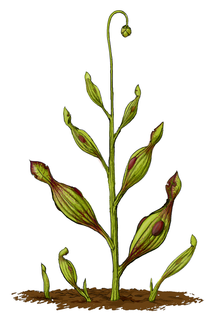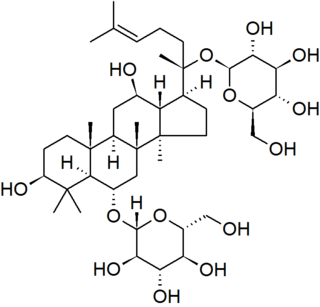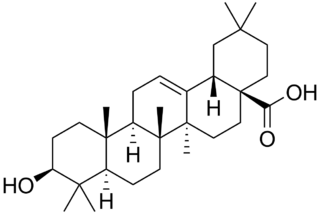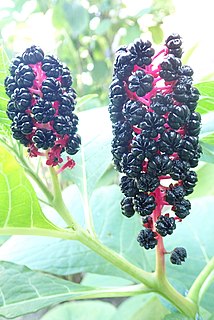
The poinsettia is a commercially important plant species of the diverse spurge family (Euphorbiaceae). Indigenous to Mexico and Central America, the poinsettia was first described by Europeans in 1834. It is particularly well known for its red and green foliage and is widely used in Christmas floral displays. It derives its common English name from Joel Roberts Poinsett, the first United States Minister to Mexico, who is credited with introducing the plant to the US in the 1820s. Poinsettias are shrubs or small trees, with heights of 0.6–4 m (2.0–13.1 ft). Though often stated to be highly toxic, the poinsettia is not dangerous to pets or children. Exposure to the plant, even consumption, most often results in no effect, though it can cause nausea, vomiting, or diarrhea.

Theaceae, the tea family, is a family of flowering plants comprising shrubs and trees, including the economically important tea plant, and the ornamental camellias. It can be described as having from seven to 40 genera, depending on the source and the method of circumscription used. The family Ternstroemiaceae has been included within Theaceae; however, the APG III system of 2009 places it instead in Pentaphylacaceae. Most but not all species are native to China and East Asia.

Lanosterol is a tetracyclic triterpenoid and is the compound from which all animal and fungal steroids are derived. By contrast plant steroids are produced via cycloartenol.

Calendula officinalis, the pot marigold, common marigold, ruddles, Mary's gold or Scotch marigold, is a flowering plant in the daisy family Asteraceae. It is probably native to southern Europe, though its long history of cultivation makes its precise origin unknown, and it may possibly be of garden origin. It is also widely naturalised farther north in Europe and elsewhere in warm temperate regions of the world.

Triterpenes are a class of chemical compounds composed of three terpene units with the molecular formula C30H48; they may also be thought of as consisting of six isoprene units. Animals, plants and fungi all produce triterpenes, including squalene, the precursor to all steroids.

Archaeamphora longicervia is a fossil plant species, the only member of the genus Archaeamphora. Fossil material assigned to this taxon originates from the Yixian Formation of northeastern China, dated to the Early Cretaceous.

Barringtonia acutangula is a species of Barringtonia native to coastal wetlands in southern Asia and northern Australasia, from Afghanistan east to the Philippines, Queensland and the Northern Territory. Common names include freshwater mangrove, itchytree and mango-pine.

Ginsenosides or panaxosides are a class of natural product steroid glycosides and triterpene saponins. Compounds in this family are found almost exclusively in the plant genus Panax (ginseng), which has a long history of use in traditional medicine that has led to the study of pharmacological effects of ginseng compounds. As a class, ginsenosides exhibit a large variety of subtle and difficult-to-characterize biological effects when studied in isolation.

Oleanolic acid or oleanic acid is a naturally occurring pentacyclic triterpenoid related to betulinic acid. It is widely distributed in food and plants where it exists as a free acid or as an aglycone of triterpenoid saponins.
Reata Pharmaceuticals, Inc. is a pharmaceutical company based in Plano, Texas. Founded in 2002, Reata is primarily focused on investigating experimental oral antioxidative and anti-inflammatory drugs, which dually activate the antioxidative transcription factor Nrf2 and inhibit the pro-inflammatory transcription factor NF-κB.

A quinone methide is a type of conjugated organic compound that contain a cyclohexadiene with a carbonyl and an exocyclic methylidene or extended alkene unit. It is analogous to a quinone, but having one of the double bonded oxygens replaced with a carbon. The carbonyl and methylidene are usually oriented either ortho or para to each other. There are some examples of transient synthetic meta quinone methides.

The amyrins are three closely related natural chemical compounds of the triterpene class. They are designated α-amyrin (ursane skeleton), β-amyrin (oleanane skeleton) and δ-amyrin. Each is a pentacyclic triterpenol with the chemical formula C30H50O. They are widely distributed in nature and have been isolated from a variety of plant sources such as epicuticular wax. In plant biosynthesis, α-amyrin is the precursor of ursolic acid and β-amyrin is the precursor of oleanolic acid. All three amyrins occur in the surface wax of tomato fruit. α-Amyrin is found in dandelion coffee.

α-Spinasterol is a stigmastane-type phytosterol found in a variety of plant sources such as spinach, from which it gets its name.

Omaveloxolone is a second generation member of the synthetic oleanane triterpenoid compounds and currently in clinical development by Reata Pharmaceuticals. Preclinical studies have demonstrated that omaveloxolone possesses antioxidative and anti-inflammatory activities and the ability to improve mitochondrial bioenergetics. Omaveloxolone is currently under clinical investigation for a variety of indications, including Friedreich’s ataxia, mitochondrial myopathies, immunooncology, and prevention of corneal endothelial cell loss following cataract surgery.
Gordonia alkanivorans is a bacterium from the genus of Gordonia which has been isolated from soil which was contaminated with tar and phenol in Rositz in Germany. Gordonia alkanivorans has the ability to metabolize hexadecane. The strain RIPI90A of Gordonia alkanivorans can desulfurize dibenzothiophene.
Gordonia jinhuaensis is a Gram-positive, aerobic, rod-shaped and non-motile bacterium from the genus of Gordonia which has been isolated from pharmaceutical wastewater from Jinhua in China.

Ploiarium is a genus of three species of woody plants in the family Bonnetiaceae. It is native to tropical forests and peat swamp forests in Southeast Asia including southern Indochina, Malay Peninsula, Sumatra, and Borneo. Species are generally slow growing with irregular flowering and fruiting cycles. Colonization of plants by arbuscular mycorrhizal fungi is known to improve growth and biomass.

Daturadiol is a pentacyclic triterpenoid found in Datura species including Datura stramonium and Datura innoxia. It is also found in non-Solanaceae plants such as Vernicia fordii and Terminalia brasiliensis.
Couepia polyandra, also known as olosapo, zapote amarillo, baboon cap, and monkey cap, is a flowering tree in the family Chrysobalanaceae.

Phytolacca acinosa, the Indian pokeweed, is a species of flowering plant in the family Phytolaccaceae. It is native to temperate eastern Asia; the Himalayas, most of China, Vietnam to Japan, and has been widely introduced to Europe. The species was originally described by William Roxburgh in 1814.















